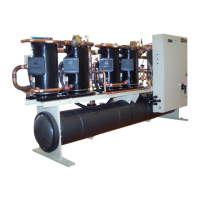78 TGZ 040A through TGZ 190A OMM TGZ-1
Oil Equalization
All compressor models come equipped with oil equalization lines connecting the
crankcases of the compressors. This allows the oil to move from one compressor crankcase
to the other during normal operation, and balance between the two when the compressors
are off. This method of equalization prohibits the oil level from dropping below the bottom
level of the sightglass in one compressor. Some difference in crankcase oil levels will still
exist during unit operation due to compressor internal pressures.
Small compressors have an oil level sightglasse in the compressor housing and a small
equalization line. Larger compressors have a larger equalization line with an oil level
sightglass in it.
Sightglass and Moisture Indicator
The refrigerant sight glasses should be observed periodically. A monthly observation
should be adequate. A clear glass of liquid indicates that there is adequate refrigerant charge
in the system to provide proper feed through the expansion valve. The sight glass should be
clear when:
• Ambient temperature is above 75°F (23°C)
• Both compressors on a circuit are running
• All fans on a circuit are running
Bubbling refrigerant in the sight glass may occur at other conditions and may indicate that
the system is short of refrigerant charge. Refrigerant gas flashing in the sight glass could
also indicate an excessive pressure drop in the line, possibly due to a clogged filter-drier or
a restriction elsewhere in the system. An element inside the sight glass indicates what
moisture condition corresponds to a given element color. If the sight glass does not indicate
a dry condition after about 12 hours of operation, the unit should be pumped down and the
filter-driers changed.
If the system is suspected of being short of refrigerant, contact a qualified service
technician with EPA certification to check out the unit and add refrigerant if necessary.
Crankcase Heaters
The compressors are equipped with crankcase heaters. The function of the heater is to keep
the temperature in the crankcase high enough to prevent refrigerant from migrating to the
crankcase and condensing in the oil during off-cycle. When a system is to be started up
initially, the power to the heaters should be turned on for at least 12 hours before the
compressors are started. The crankcase should be at about 80°F (26.7°C) before the system
is started up, to minimize lubrication problems or liquid slugging of compressor on start-up.
If the crankcase is cool (below 80°F) (26.7°C) and the oil level in the sight glass is full to
top, allow more time for oil to warm before starting the compressor.
The crankcase heaters are on whenever power is supplied to the unit and the compressor is
not running.

